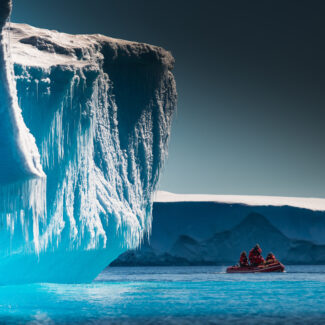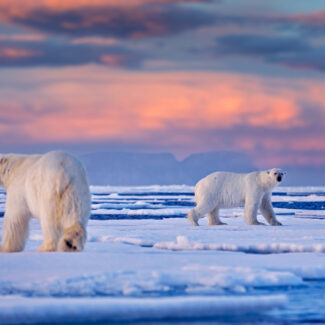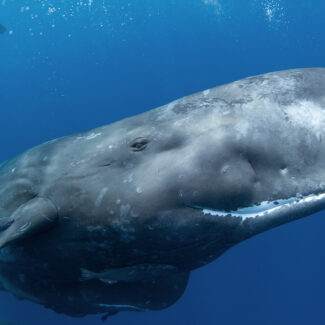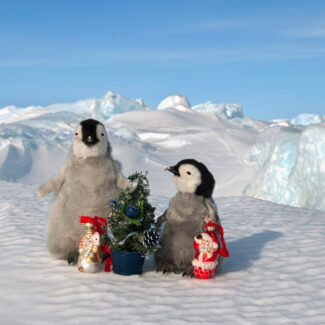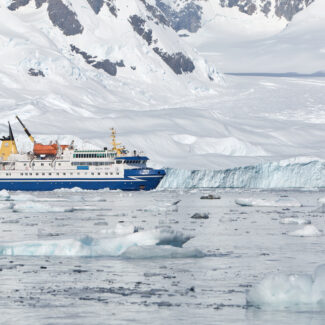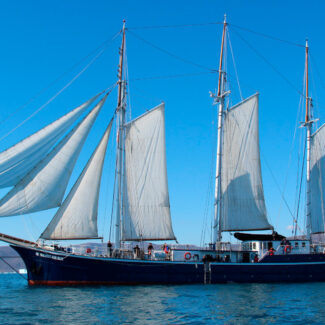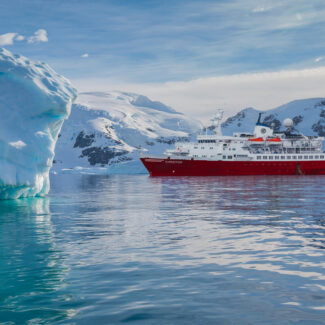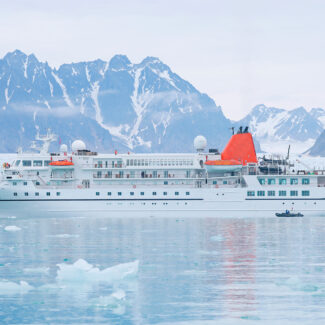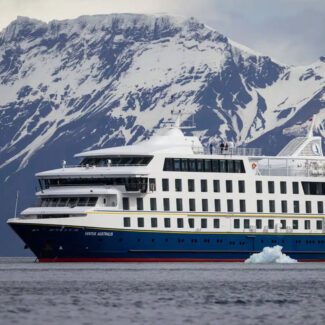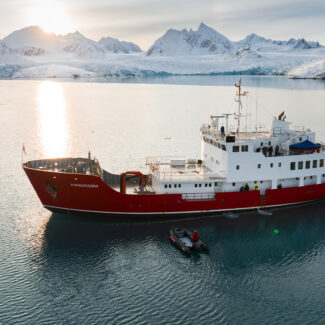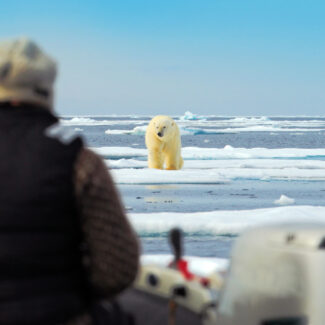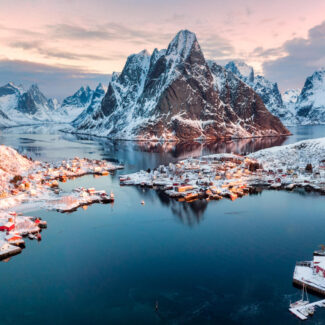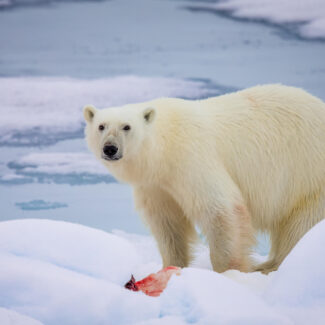Why Is The Snow Antarctica Turning Green, Red & Pink? Algae!
What color is snow? White, of course—next question! But hold on: Not all snow is that classic white hue, and we’re not just talking about those dirty, sooty, rather dreary snowbanks that tend to accumulate along city streets and parking lots by late winter.
Sightseeing along the spectacular Antarctic Peninsula, you may well spot some downright colorful—almost kaleidoscopic—swaths of snow: red, orange, green, yellow, and other shades (see image above, courtesy of Stephen Powell of the Australian AntarcticProgram). Is it some depressing sign of pollution here in what’s otherwise the most pristine continent left on Planet Earth? Nope!
Let’s dig into some of the reasons why some Antarctic snow (and ice) takes on a decidedly non-white coat.
Algae: The Photosynthetic Powerhouses Behind “Watermelon Snow,” “Blood Snow,” & More
The most significant cause of colored snow—not only in Antarctica but also other polar locales as well as high mountains—is the aptly named snow algae. That’s right: There are actually organisms growing on and within the snowpack, and in the case of algae, they can put on a dazzling color show. Common colors include green, red (sometimes called “blood snow”), pink (“watermelon snow”), orange, yellow, and even gray.
Red algae in the Antarctic snow (Photo: Bob Jones, Australian Antarctic Program)
Snow algae, which are thought to have likely evolved from aquatic or soil-living ancestors, show a variety of special adaptations that allow them to survive in their chilly chosen habitat of polar and alpine snowfields. And this is a category, not a single taxonomic group: There are, in fact, multiple genera and species of snow algae, with more surely to be identified. (Scientists have identified some 700 species of algae in Antarctica, from marine types to those inhabiting bedrock pores.)
Snow algae undergo a variety of distinct life-stage forms, which is one reason why they prosper in the cold, sun-blasted snowfields they colonize. Their spores are super-hardy, able to endure the extremes of frigid winter temperatures and desiccating summer sunshine.
From the immobile algal spores to colonizing motile cells and vegetative cells, the different life stages of snow algae may feature different pigments that partly account for the variety of colors produced. These pigments help protect the algal cells from UV radiation and other light damage.
There’s still much scientists don’t know about snow algae, not least in the remote environs of the White Continent. A 2020 study on green snow algae on the Antarctic Peninsula found their distribution broadly reflected areas with average summer temperatures a little above freezing. That research surveyed green snow algae by inventorying the intense algal “blooms” that take place in the austral summer, which (as the Australian Antarctic Program notes) can produce concentrations of more than 100 algal cells per milliliter of snow.
Using satellite imagery and on-the-ground field methods, the researchers counted almost 1,700 blooms on the Antarctic Peninsula that collectively accounted for about 1.9 square kilometers. The majority of blooms were found close to bird rookeries, particularly penguin colonies, as well as seal haul-outs, so likely the (ahem) excrement of these animals provides a big-time nutritive boost for algal growth.
A recently tipped iceberg brown with algae (Photo: Kerry Steinberner, Australian Antarctic Program)
That 2020 study, published in Nature Communications, suggests that snow algae—which, like green plants, produce their own energy from sunlight via photosynthesis—may be the most important primary producers on the Antarctic Peninsula, where only a small percentage of bare, ice-free ground support vegetation. Furthermore, the snow algal blooms are also likely major sources of nutrients for both terrestrial and marine ecosystems along the Peninsula.
They also constitute a potentially important carbon sink: The study estimated that the biomass of green snow algae on the Antarctic Peninsula shook out to the vicinity of 479 tonnes of absorbed carbon per year.
There’s also evidence that—despite the potential loss of green snow algae on low-lying Antarctic islands vulnerable to sea-level rise—algal blooms may increase on the Antarctic Peninsula, the most rapidly warming part of the White Continent, as climate change continues. Slightly warmer temperatures and slushier snowpacks (favored by the algae) might allow for an expansion of blooms on the Peninsula, “greening up” more snow there. How that might affect snow reflectivity and thus melting rates and overall snowcover remain to be determined.
The team that undertook that study of green snow algae on the Antarctic Peninsula intend to expand their research into red and orange blooms as well, so our knowledge of these fascinating microorganisms is hopefully set to expand further in the near future…
(Learn more about algae as well as lichens and plants of Antarctica here.)
Antarctica’s Blood Falls oozes its crimson waters, but this isn’t due to algae as first believed…
Other Causes of Colorful Snow in Antarctica
Snow algae—green snow algae, anyhow—may preferentially set up shop close to penguin rookeries, but they’re not the only reason you might see colorful snow around those noisy colonies. Naturally, they produce a prodigious amount of guano, and the krill-heavy diets of many penguins can result in pinkish guano and thus pink-stained snow. (And an aroma, let’s just say.)
Variations in glacial and marine ice formation as well as other factors help influence the hue of Antarctic icebergs, meanwhile. As glacial ice compresses, air bubbles are forced out to produce very dense ice that absorbs longer wavelengths such as red more efficiently than shorter wavelengths such as blue. Thus, very dense glacial ice appears blueish to our eyes. Icebergs generally look white because of their accumulated coatings of snow, and meanwhile dirt and weathering can dirty their surface. If you’re lucky enough to see a recently upturned ‘berg, though, you might see a dazzling blue-ice underbelly suddenly exposed above water.
How about red ice in Antarctica? Well, just consider Blood Falls at the terminus of the Taylor Glacier in the McMurdo Dry Valleys: one of the craziest-looking landmarks in Antarctica, though not one many tourists get to see.
Once it was believed that algae produced the crimson gurgle at Blood Falls, but we now know that’s not the case: Iron-rich brine sequestered under the surface of the Taylor Glacier outflows at Blood Falls, and upon coming in contact with the atmosphere, iron particles oxidize to produce the (rather gruesome) reddish hue. You can read all about Blood Falls and its inner workings in this article!
Disclaimer
Our travel guides are for informational purposes only. While we aim to provide accurate and up-to-date information, Antarctica Cruises makes no representations as to the accuracy or completeness of any information in our guides or found by following any link on this site.
Antarctica Cruises cannot and will not accept responsibility for any omissions or inaccuracies, or for any consequences arising therefrom, including any losses, injuries, or damages resulting from the display or use of this information.


